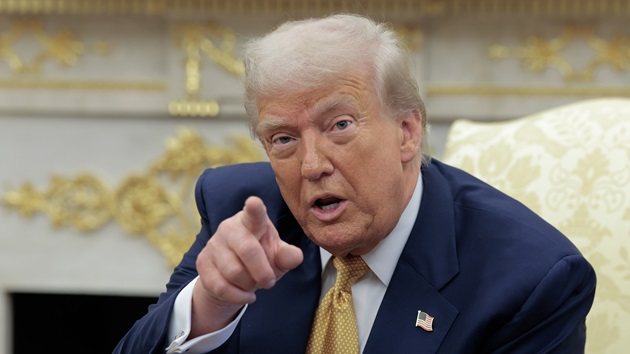
(NEW YORK) — President Donald Trump unveiled a trade agreement with the European Union on Sunday, making it the latest in a series of accords as the White House threatens to slap tariffs on dozens of countries this week.
Prior to the agreement, the European Union faced the prospect of a 30% tariff rate set to take effect Aug. 1. Instead, products from one of the largest U.S. trade partners will be slapped with a 15% tariff.
In exchange, the EU said European companies would buy $750 billion worth of energy-related goods over three years and invest an extra $600 billion in the U.S.
Speaking to reporters on Sunday, Trump touted the agreement as the “biggest deal ever made.” The White House has yet to release full details of the accord.
European Commission President Ursula von der Leyen said the agreement “creates certainty in uncertain times. It delivers stability and predictability for citizens and businesses on both sides of the Atlantic.”
Here’s what to know about what’s in the trade agreement and what comes next:
What’s in the U.S. trade agreement with the European Union?
The trade agreement lowers the tariff rate on European products to 15%, putting it below the threatened rate of 30% but higher than a universal rate of 10% faced by nearly all imports.
The 15% tariffs on European products match the level of levies established for Japanese goods in a separate agreement last week. A trade agreement with Vietnam earlier this month set U.S. tariffs at 20%, while Chinese goods currently face 30% tariffs.
The agreement includes tariff exemptions for aircraft, semiconductor equipment and some chemical and agricultural goods, von der Leyen said.
The European Union purchased about $370 billion worth of U.S. products in 2024, while the U.S. bought about $605 billion worth of Japanese goods, according to the Office of the U.S. Trade Representative, a government agency.
Last year, the U.S. goods trade deficit with the EU was $235.6 billion, which marked a nearly 13% increase from 2023, the agency said.
Top U.S imports from Europe include pharmaceuticals, cars, machinery, wine and perfume.
Tariffs typically raise prices as importers pass along a share of the tax burden to consumers, though prices have largely averted major tariff-related hikes so far.
In exchange for the softening of U.S. tariffs, the EU agreed to reduce its tariff on U.S.-made cars from 10% to 2.5%.
The EU also said European companies would buy $750 billion worth of energy-related goods over three years and invest an extra $600 billion in the U.S.
What’s next ahead of Trump’s tariff deadline on Aug. 1?
So far, Trump has brokered agreements with the United Kingdom, Indonesia, Vietnam, the Philippines, Japan and the European Union. The White House also reached a preliminary accord with China that lowered tit-for-tat tariffs previously imposed by the world’s two largest economies.
On Friday, tariffs are set to take effect for dozens of additional countries, including some of the nation’s major trade partners: Canada, Mexico, South Korea and Brazil.
For his part, the president has insisted that the on-again, off-again levies make up a key part of his negotiation strategy.
“The president and his trade team want to cut the best deals for the American people and the American worker,” White House press secretary Karoline Leavitt said last month when she announced the Aug. 1 deadline.
When asked on Sunday whether the Aug. 1 deadline could be extended, Trump said, “No.”
“Aug. 1 is there for everyone,” Trump added. “The deals all start on Aug. 1.”
Copyright © 2025, ABC Audio. All rights reserved.


